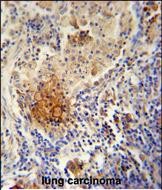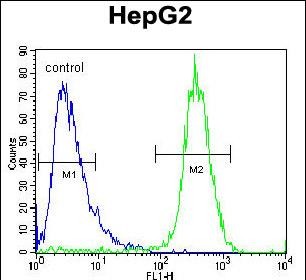TYROBP Antibody (C-term)
Affinity Purified Rabbit Polyclonal Antibody (Pab)
- 产品详情
- 实验流程
- 背景知识
Application
| WB, IHC-P, FC, E |
|---|---|
| Primary Accession | O43914 |
| Other Accession | Q95J79 |
| Reactivity | Human |
| Predicted | Bovine |
| Host | Rabbit |
| Clonality | Polyclonal |
| Isotype | Rabbit IgG |
| Calculated MW | 12179 Da |
| Antigen Region | 85-113 aa |
| Gene ID | 7305 |
|---|---|
| Other Names | TYRO protein tyrosine kinase-binding protein, DNAX-activation protein 12, Killer-activating receptor-associated protein, KAR-associated protein, TYROBP, DAP12, KARAP |
| Target/Specificity | This TYROBP antibody is generated from rabbits immunized with a KLH conjugated synthetic peptide between 85-113 amino acids from the C-terminal region of human TYROBP. |
| Dilution | WB~~1:1000 IHC-P~~1:100~500 FC~~1:10~50 E~~Use at an assay dependent concentration. |
| Format | Purified polyclonal antibody supplied in PBS with 0.09% (W/V) sodium azide. This antibody is purified through a protein A column, followed by peptide affinity purification. |
| Storage | Maintain refrigerated at 2-8°C for up to 2 weeks. For long term storage store at -20°C in small aliquots to prevent freeze-thaw cycles. |
| Precautions | TYROBP Antibody (C-term) is for research use only and not for use in diagnostic or therapeutic procedures. |
| Name | TYROBP (HGNC:12449) |
|---|---|
| Function | Adapter protein which non-covalently associates with activating receptors found on the surface of a variety of immune cells to mediate signaling and cell activation following ligand binding by the receptors (PubMed:10604985, PubMed:9490415, PubMed:9655483). TYROBP is tyrosine-phosphorylated in the ITAM domain following ligand binding by the associated receptors which leads to activation of additional tyrosine kinases and subsequent cell activation (PubMed:9490415). Also has an inhibitory role in some cells (PubMed:21727189). Non-covalently associates with activating receptors of the CD300 family to mediate cell activation (PubMed:15557162, PubMed:16920917, PubMed:17928527, PubMed:26221034). Also mediates cell activation through association with activating receptors of the CD200R family (By similarity). Required for neutrophil activation mediated by integrin (By similarity). Required for the activation of myeloid cells mediated by the CLEC5A/MDL1 receptor (PubMed:10449773). Associates with natural killer (NK) cell receptors such as KIR2DS2 and the KLRD1/KLRC2 heterodimer to mediate NK cell activation (PubMed:23715743, PubMed:9490415, PubMed:9655483). Also enhances trafficking and cell surface expression of NK cell receptors KIR2DS1, KIR2DS2 and KIR2DS4 and ensures their stability at the cell surface (PubMed:23715743). Associates with SIRPB1 to mediate activation of myeloid cells such as monocytes and dendritic cells (PubMed:10604985). Associates with TREM1 to mediate activation of neutrophils and monocytes (PubMed:10799849). Associates with TREM2 on monocyte-derived dendritic cells to mediate up-regulation of chemokine receptor CCR7 and dendritic cell maturation and survival (PubMed:11602640). Association with TREM2 mediates cytokine-induced formation of multinucleated giant cells which are formed by the fusion of macrophages (PubMed:18957693). Stabilizes the TREM2 C-terminal fragment (TREM2-CTF) produced by TREM2 ectodomain shedding which suppresses the release of pro-inflammatory cytokines (PubMed:25957402). In microglia, required with TREM2 for phagocytosis of apoptotic neurons (By similarity). Required with ITGAM/CD11B in microglia to control production of microglial superoxide ions which promote the neuronal apoptosis that occurs during brain development (By similarity). Promotes pro-inflammatory responses in microglia following nerve injury which accelerates degeneration of injured neurons (By similarity). Positively regulates the expression of the IRAK3/IRAK-M kinase and IL10 production by liver dendritic cells and inhibits their T cell allostimulatory ability (By similarity). Negatively regulates B cell proliferation (PubMed:21727189). Required for CSF1-mediated osteoclast cytoskeletal organization (By similarity). Positively regulates multinucleation during osteoclast development (By similarity). |
| Cellular Location | Cell membrane; Single-pass type I membrane protein |
| Tissue Location | Expressed at low levels in the early development of the hematopoietic system and in the promonocytic stage and at high levels in mature monocytes. Expressed in hematological cells and tissues such as peripheral blood leukocytes and spleen. Also found in bone marrow, lymph nodes, placenta, lung and liver. Expressed at lower levels in different parts of the brain especially in the basal ganglia and corpus callosum. |
For Research Use Only. Not For Use In Diagnostic Procedures.
Provided below are standard protocols that you may find useful for product applications.
BACKGROUND
TYROBP encodes a transmembrane signaling polypeptide which contains an immunoreceptor tyrosine-based activation motif (ITAM) in its cytoplasmic domain. The encoded protein may associate with the killer-cell inhibitory receptor (KIR) family of membrane glycoproteins and may act as an activating signal transduction element. This protein may bind zeta-chain (TCR) associated protein kinase 70kDa (ZAP-70) and spleen tyrosine kinase (SYK) and play a role in signal transduction, bone modeling, brain myelination, and inflammation. Mutations within this gene have been associated with polycystic lipomembranous osteodysplasia with sclerosing leukoencephalopathy (PLOSL), also known as Nasu-Hakola disease. Its putative receptor, triggering receptor expressed on myeloid cells 2 (TREM2), also causes PLOSL.
REFERENCES
Chen, X., et al. Blood 113(14):3226-3234(2009)
Sulonen, A.M., et al. J. Neuroimmunol. 206 (1-2), 86-90 (2009)
Lanier, L.L. Immunol. Rev. 227(1):150-160(2009)
Schleinitz, N., et al. PLoS ONE 4 (7), E6264 (2009)
终于等到您。ABCEPTA(百远生物)抗体产品。
点击下方“我要评价 ”按钮提交您的反馈信息,您的反馈和评价是我们最宝贵的财富之一,
我们将在1-3个工作日内处理您的反馈信息。
如有疑问,联系:0512-88856768 tech-china@abcepta.com.























 癌症的基本特征包括细胞增殖、血管生成、迁移、凋亡逃避机制和细胞永生等。找到癌症发生过程中这些通路的关键标记物和对应的抗体用于检测至关重要。
癌症的基本特征包括细胞增殖、血管生成、迁移、凋亡逃避机制和细胞永生等。找到癌症发生过程中这些通路的关键标记物和对应的抗体用于检测至关重要。 为您推荐一个泛素化位点预测神器——泛素化分析工具,可以为您的蛋白的泛素化位点作出预测和评分。
为您推荐一个泛素化位点预测神器——泛素化分析工具,可以为您的蛋白的泛素化位点作出预测和评分。 细胞自噬受体图形绘图工具为你的蛋白的细胞受体结合位点作出预测和评分,识别结合到自噬通路中的蛋白是非常重要的,便于让我们理解自噬在正常生理、病理过程中的作用,如发育、细胞分化、神经退化性疾病、压力条件下、感染和癌症。
细胞自噬受体图形绘图工具为你的蛋白的细胞受体结合位点作出预测和评分,识别结合到自噬通路中的蛋白是非常重要的,便于让我们理解自噬在正常生理、病理过程中的作用,如发育、细胞分化、神经退化性疾病、压力条件下、感染和癌症。








